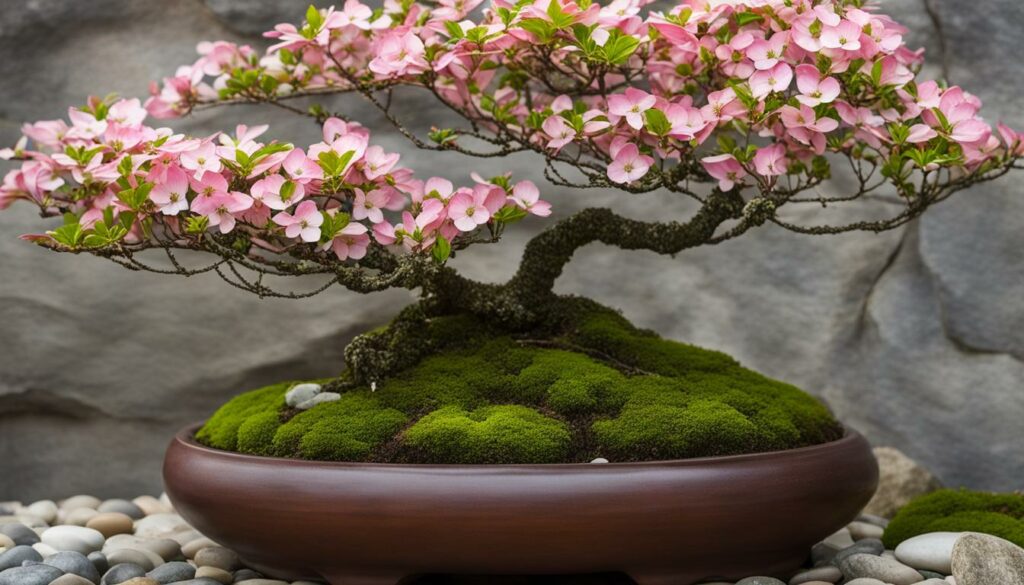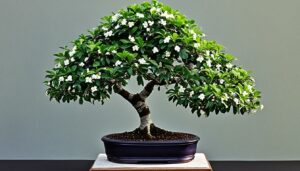In this article, you will discover the elegance and versatility of the Bonsai Tree Species Dogwood. If you want to cultivate a beautiful flowering bonsai for your home or garden, then the Dogwood bonsai may be the perfect choice for you.
The Cornus bonsai, commonly known as Dogwood, is renowned for its exquisite flowers and unique appearance. This bonsai tree species is a popular choice among bonsai enthusiasts, owing to its versatility and ease of cultivation. With proper care and nurturing, the Dogwood bonsai can thrive and demonstrate its natural beauty.
Key Takeaways:
- The Dogwood bonsai is a popular choice for bonsai enthusiasts due to its versatility and ease of cultivation
- The Cornus bonsai showcases its beauty through its flowers
- The Dogwood bonsai requires proper care and nurturing to thrive
- With the right techniques, the Dogwood bonsai can be shaped and styled to enhance its aesthetic appeal
- Creative display options can highlight the beauty of the Dogwood bonsai in your home or garden
Introduction to Dogwood Bonsai
If you’re looking for a unique and elegant bonsai tree, look no further than the Dogwood bonsai. This Bonsai Tree Species Dogwood has many unique characteristics that make it a popular choice for bonsai enthusiasts.
The Dogwood bonsai belongs to the Cornus bonsai family and is known for its beautiful flowers. The different varieties of Cornus bonsai showcase their beauty through their flowers which come in different hues and colors, making it a delightful sight to behold.
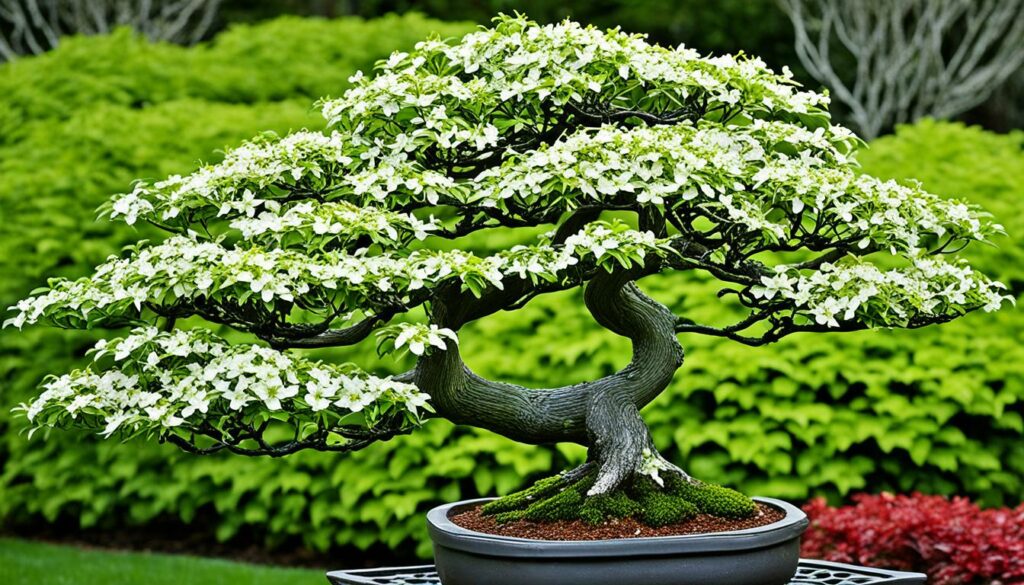
“Dogwood bonsai, also known as Cornus bonsai, is a beautiful and unique option for any bonsai enthusiast. Their hues and colors are truly mesmerizing.”
Growing Dogwood Bonsai: Essential Tips
Are you ready to start growing your own Cornus bonsai? Keep these essential tips in mind to ensure the success of your flowering bonsai:
Ideal Growing Conditions
Cornus bonsai thrives in a temperate climate with an adequate amount of sunlight. The ideal temperature range is between 55 to 75 degrees Fahrenheit, with a relative humidity of 60 to 70%. Place your bonsai in a sheltered area that’s protected from strong winds and direct sunlight.
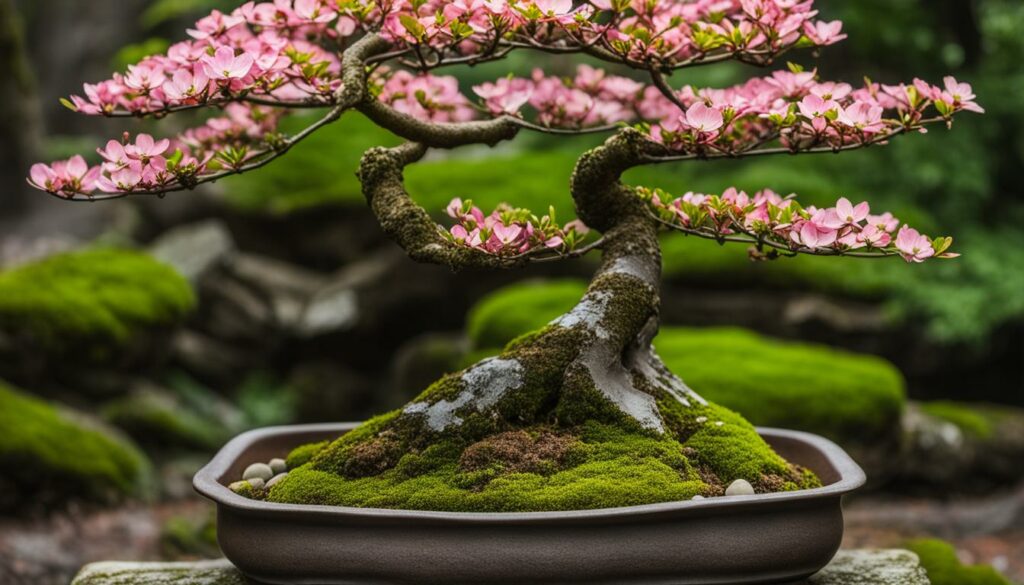
Watering Requirements
Proper watering is critical in maintaining the health of your Cornus bonsai. The soil should be kept moist but not overly saturated. Check the soil regularly and water only when the top inch of soil feels dry to the touch. Avoid watering the foliage to prevent waterlogging and fungal diseases.
Pruning Techniques
Pruning is essential in shaping your Dogwood bonsai and promoting healthy growth. Use sharp, clean pruning shears to remove dead or damaged branches. Pinch back new growth regularly to encourage branching and maintain the desired shape of your bonsai.
Fertilizer and Soil Requirements
Use a well-draining soil mix that’s rich in organic matter and nutrients to ensure the health and growth of your Cornus bonsai. Fertilize your bonsai during the growing season with a balanced fertilizer to promote healthy foliage and flower production.
By following these tips, you can ensure the health and vitality of your flowering Cornus bonsai.
Dogwood Bonsai Care: Diseases and Pests
Just like any plant, Dogwood bonsai is also susceptible to a range of different diseases and pest infestations that can endanger the health and beauty of your Cornus bonsai. Here are some common ones to be aware of:
Diseases:
| Disease | Symptoms | Treatment |
|---|---|---|
| Leaf spot | Yellow or brown spots on leaves, defoliation | Remove infected leaves and improve airflow; fungicides |
| Powdery mildew | White powdery coating on leaves | Remove infected leaves and improve airflow; fungicides |
| Root rot | Soggy, discolored roots, wilting leaves | Adjust watering schedule and improve soil drainage |
Pests:
| Pest | Symptoms | Treatment |
|---|---|---|
| Spider mites | Brown or yellow leaves, fine webbing on foliage | Insecticides or predatory mites |
| Japanese beetles | Skeletonized leaves | Handpicking or insecticides |
| Aphids | Stunted growth, distorted leaves, honeydew secretion | Insecticidal soap or neem oil |
Prevention is the best method for keeping your Dogwood bonsai safe from diseases and pests. Ensure proper watering and ventilation, and check your bonsai regularly for signs of infestation. Act quickly if you detect any problems to minimize damage, and use appropriate treatments and remedies to protect the health and beauty of your flowering bonsai.
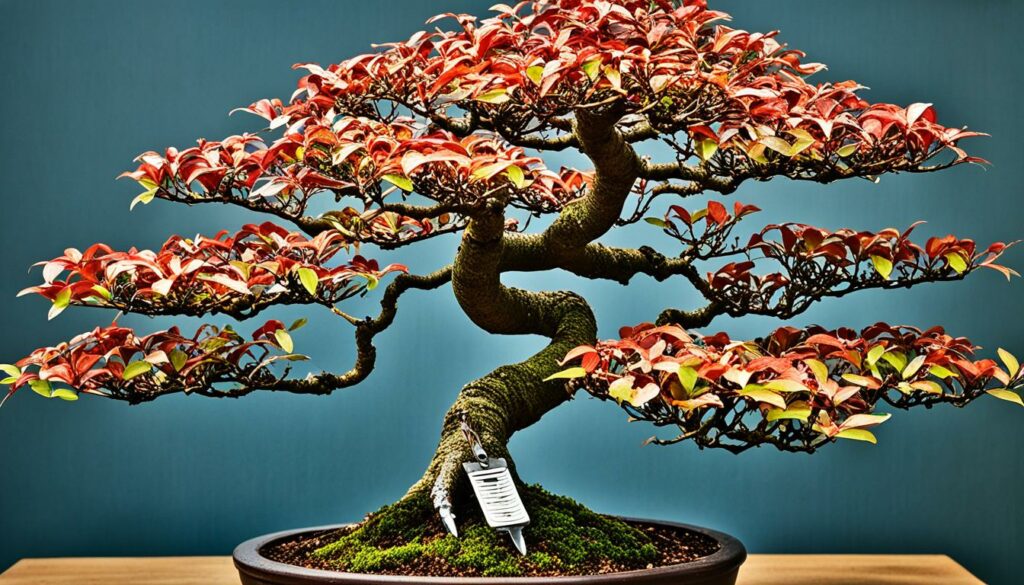
Styling Dogwood Bonsai: Techniques and Tips
Shaping your Dogwood bonsai is an exciting stage of its development, providing you with the ability to sculpt the tree’s growth and create a harmonious and balanced look. Here are some techniques and tips to help you style your Cornus bonsai:
Pruning
Pruning plays a vital role in controlling the growth of your Dogwood bonsai. Use gardening shears to remove any unwanted branches or foliage, focusing on maintaining a balanced silhouette. You can also use pruning to enhance the natural curves and shapes of your Cornus bonsai.
Wiring
Wiring is an essential technique for shaping your Dogwood bonsai, allowing you to bend and direct branches in the desired direction. When wiring your Cornus bonsai, be gentle to avoid damaging the tree. Also, be sure to remove the wire promptly to prevent it from constricting the tree’s growth.
| Tip: | Use raffia to wrap around the branch before applying wire to protect the bark and prevent wire marks. |
|---|
Positioning
Positioning your Dogwood bonsai is crucial to ensure that it is displayed in the most aesthetically pleasing way. When positioning your Cornus bonsai, consider its size, shape, and the styling techniques that you have used. A popular display method is the slanting style, where the tree appears to be tilted slightly forward, creating a unique and dynamic display.
Assessing Progress
Regularly assessing the progress of your Dogwood bonsai is essential to ensure that it is developing in line with your desired styling technique. Be patient and allow the tree to grow, making appropriate adjustments throughout the growing season.
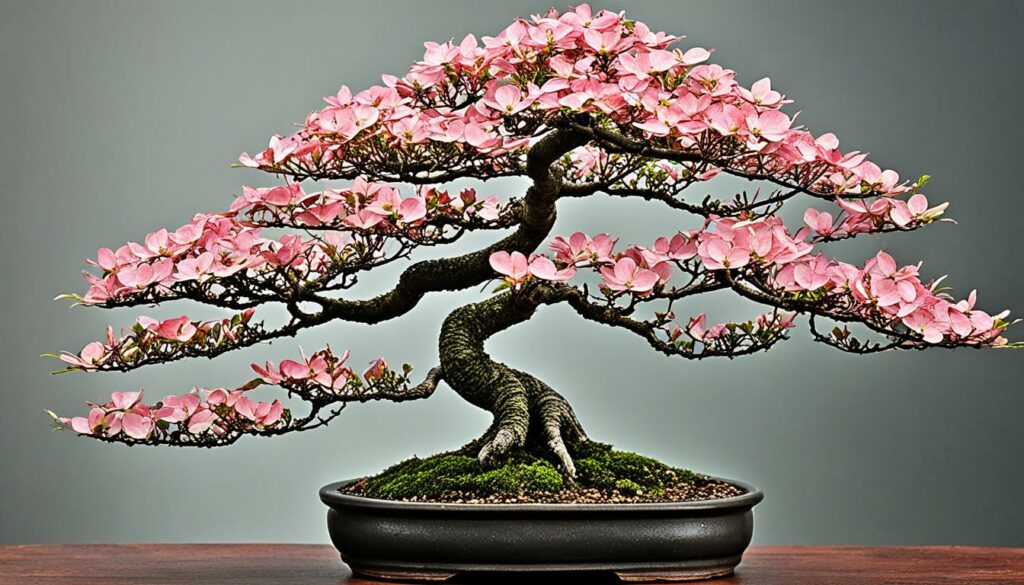
With these techniques and tips, you can shape your Dogwood bonsai into a beautiful and unique masterpiece that showcases its natural beauty. Remember to always approach styling with care and thoughtfulness, allowing the Cornus bonsai to thrive and grow in health and vitality.
Showcasing the Beauty: Displaying Dogwood Bonsai
Now that you’ve cultivated your beautiful Cornus bonsai, it’s time to showcase its aesthetic appeal with creative display options.
Consider placing your flowering bonsai in a suitable pot that complements its beauty. Terracotta and ceramic pots are popular choices, but you can also opt for wooden or metal containers depending on your preference.
Stands are another great way to display your Cornus bonsai, providing elevation and emphasizing its delicate branches and flowers. You can choose from a variety of materials and styles, such as bamboo, metal, or wooden stands with intricate designs.
When positioning your Dogwood bonsai, ensure that it is exposed to adequate sunlight and positioned away from harsh environmental factors. You can also consider surrounding the bonsai with natural elements such as rocks or moss to create a harmonious and serene display.
With the right display strategy, you can enhance the natural beauty of your Cornus bonsai and create a stunning display that delights the senses.
Table 6: Suitable Display Options for Dogwood Bonsai
| Display Option | Description |
|---|---|
| Porcelain pot | A delicate and elegant option that highlights the beauty of the Dogwood bonsai’s flowers. |
| Bamboo stand | A nature-inspired choice that provides a subtle yet sophisticated display option. |
| Metal container | A sleek and modern option that complements the Dogwood bonsai’s foliage and branches. |
| Wooden pedestal | A rustic and charming option that adds warmth and depth to the display. |
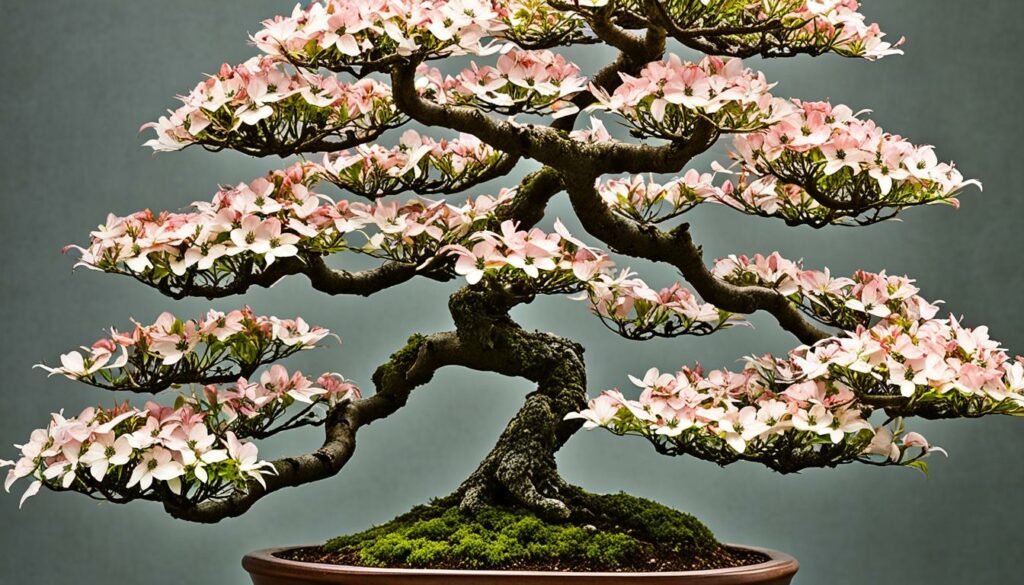
Dogwood Bonsai Propagation: A Step-by-Step Guide
If you want to multiply your Cornus bonsai collection, propagation through seeds, cuttings, and layering is the way to go. Here’s a step-by-step guide to propagating your Cornus bonsai:
- Propagation by seeds: Collect the seeds from the Dogwood bonsai during the fall season and store them in a cool, dry place for several weeks. Fill a pot with well-draining soil and plant the seeds about an inch deep. Keep the soil consistently moist and place the pot in a bright, indirect light. The seeds will sprout within a few weeks, and you can transplant them once they have a few sets of leaves.
- Propagation by cuttings: Take a cutting of your flowering bonsai during the late spring or early summer. Use a sharp, sterile knife to make a clean cut below a node, which is where the leaf attaches to the stem. Dip the cut end in rooting hormone and plant it in a pot filled with well-draining soil. Keep the soil moist and cover the pot with a clear plastic bag to maintain high humidity. Place the pot in a warm, bright area, and the cutting will root within a few weeks.
- Propagation by layering: Layering is the process of rooting a branch while it is still attached to the mother plant. In early spring, choose a healthy branch and wound it by removing a thin strip of bark. Apply rooting hormone to the wounded area and wrap it in moist sphagnum moss. Cover the moss with plastic wrap and secure it with a rubber band. After a few months, roots will form, and you can cut the rooted branch from the mother plant and plant it in a pot filled with well-draining soil.
Propagation is a rewarding way to increase your Cornus bonsai collection and share the beauty of these flowering bonsai with others. With a little patience and care, you can successfully propagate Dogwood bonsai and enjoy their stunning blooms for years to come.
Conclusion
In conclusion, growing a Dogwood bonsai can be a rewarding and fulfilling experience. With the right care and attention, your Cornus bonsai can flourish and bloom with stunning flowers. Remember to provide adequate growing conditions, such as well-draining soil and ample light, and to prune and wire your Dogwood bonsai regularly to maintain its shape and beauty.
By following the tips and techniques highlighted in this Bonsai Tree Species Deep Dive, you can showcase the timeless elegance and versatility of Dogwood bonsai in your own home or garden. Whether you are a seasoned bonsai enthusiast or a beginner, the joy of growing a flowering bonsai cannot be overstated. So, go ahead, and give it a try!
Thank you for reading this article. We hope you have found it informative and useful. For more information on Bonsai Tree Species Dogwood, Dogwood bonsai, Cornus bonsai, and flowering bonsai, stay tuned for more articles from our team.
FAQ
What is Dogwood bonsai?
Dogwood bonsai refers to the cultivation of Dogwood trees, specifically the Cornus species, as miniature bonsai trees. They are popular for their beautiful flowers and elegant branches, making them a stunning addition to any bonsai collection.
How do I care for Dogwood bonsai?
To care for your Dogwood bonsai, you should provide it with well-draining soil, ample sunlight, and regular watering. Prune and wire the branches as needed to maintain its desired shape, and protect it from common pests and diseases.
Can I grow Dogwood bonsai indoors?
While Dogwood bonsai can be grown indoors, they typically prefer to be outdoors in a location with plenty of sunlight. If you choose to keep your Dogwood bonsai indoors, make sure it receives sufficient light and humidity to thrive.
How often should I water my Dogwood bonsai?
The watering frequency for your Dogwood bonsai will depend on various factors such as the climate, soil type, and size of the pot. As a general guideline, check the moisture content of the soil regularly and water when the top inch feels slightly dry.
What are the common pests and diseases that can affect Dogwood bonsai?
Some common pests that can affect Dogwood bonsai include aphids, scale insects, and spider mites. Diseases such as powdery mildew and root rot can also occur. Regularly inspect your bonsai for any signs of infestation or disease and take appropriate measures to address them.
How can I style my Dogwood bonsai?
Styling your Dogwood bonsai involves pruning and wiring the branches to create the desired shape and aesthetics. Consider the natural growth patterns of the tree and aim for a balanced and harmonious look. Regularly trim back new growth to maintain the desired shape.
Can I propagate Dogwood bonsai from seeds?
Yes, you can propagate Dogwood bonsai from seeds. Collect seeds from mature Dogwood trees and sow them in a suitable growing medium. It is important to note that growing Dogwood bonsai from seeds may take several years before the tree reaches the desired size and maturity.
Can I display my Dogwood bonsai indoors?
While Dogwood bonsai are typically displayed outdoors to enjoy natural sunlight and fresh air, you can also display them indoors for short periods. When displaying indoors, ensure that the bonsai receives adequate light and proper humidity to prevent any adverse effects on its health.
